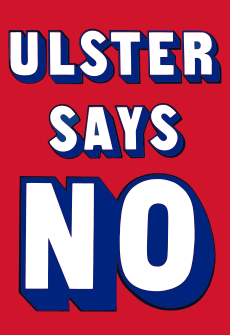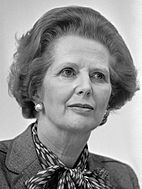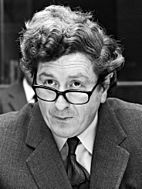Anglo-Irish Agreement facts for kids
| Signed | 15 November 1985 |
|---|---|
| Location | Hillsborough Castle, Northern Ireland |
| Original signatories |
|
| Parties | |
| Language | English |
The Anglo-Irish Agreement was an important deal signed in 1985 between the United Kingdom and the Republic of Ireland. Its main goal was to help end a long period of conflict and violence in Northern Ireland, known as the Troubles.
This agreement gave the Irish government a say in Northern Ireland's affairs. However, it also confirmed that Northern Ireland would remain part of the UK unless most of its people voted to join the Republic of Ireland. The agreement also aimed to create a shared government in Northern Ireland.
The agreement was officially signed on November 15, 1985. It happened at Hillsborough Castle in Northern Ireland. The people who signed it were Margaret Thatcher, the British Prime Minister, and Garret FitzGerald, the Irish Taoiseach (prime minister).
Contents
Why the Agreement Happened
Early Efforts for Peace
Before this agreement, British Prime Minister Margaret Thatcher had tried to talk about peace in Northern Ireland. She met with Irish leaders like Jack Lynch and Charles Haughey. In 1980, Thatcher and Haughey even discussed new ways for Britain, Northern Ireland, and the Republic of Ireland to work together.
This led to the creation of the Anglo-Irish Intergovernmental Council in 1981. However, relations between Britain and Ireland became difficult. This was due to events like the 1981 Irish hunger strike. So, this new council was not used much at first.
Seeking a Political Solution
The IRA was carrying out attacks in Britain. This included bombings in London in the early 1980s. Margaret Thatcher herself was targeted in a bombing in 1984.
British intelligence told Thatcher that military action alone would not stop the violence. This made her realize that a political solution was needed to end the Troubles. Secret talks began between British and Irish officials.
The New Ireland Forum and US Influence
In 1983, the New Ireland Forum was set up by John Hume. Its aim was to bring together Irish nationalist parties. They hoped to find peaceful ways to solve the conflict. The Forum suggested ideas like a united Ireland or shared control.
However, Margaret Thatcher publicly rejected all these ideas. This made the US President, Ronald Reagan, get involved. Many powerful Irish-American leaders, like Tip O'Neill, pushed Reagan to encourage talks. Reagan told Thatcher that making progress was very important.
By 1985, Thatcher realized she needed to make progress. She wanted better security but knew she had to make some compromises. She also hoped to improve relations with the Catholic community in Northern Ireland.
What the Agreement Included
Anglo-Irish Intergovernmental Conference
The agreement created the Anglo-Irish Intergovernmental Conference. This group included officials from both the British and Irish governments. They discussed political, legal, and security issues in Northern Ireland. They also worked on ways to cooperate across the border.
This Conference could only give advice; it could not make laws or decisions. Its role was to make suggestions, especially if Northern Ireland did not have its own local government. This was meant to encourage unionists to agree to a shared government.
The Conference also had a permanent office called the Maryfield Secretariat. It was located in Belfast and included officials from the Republic of Ireland. Unionists were particularly upset by the presence of Irish officials in Northern Ireland. This office closed in 1998.
Security Promises
As part of the agreement, the UK promised that most British Army patrols in Northern Ireland would have a civilian police escort. This was meant to improve trust. However, the Irish government often protested that this promise was not always kept.
How People Reacted
Support for the Agreement
The British Parliament voted strongly in favor of the agreement. Most members of the Conservative Party supported it. In Northern Ireland, only the nationalist Social Democratic and Labour Party (SDLP) and the Alliance Party supported it.
The Irish Parliament also approved the agreement. Most parties in the Republic of Ireland supported it. However, the main opposition party, Fianna Fáil, led by Charles Haughey, rejected it. They argued it went against parts of the Irish Constitution.
An opinion poll in the Republic of Ireland showed that 59% of people approved of the agreement.
Unionist Opposition

The agreement was strongly rejected by unionists in Northern Ireland. They were angry because it gave the Republic of Ireland a role in Northern Ireland's government for the first time. They also felt left out of the negotiations.
The two main unionist parties, the Ulster Unionist Party (UUP) and the Democratic Unionist Party (DUP), led protests. These included large rallies, strikes, and civil disobedience. All unionist Members of Parliament (MPs) even resigned from the British Parliament.
A huge rally was held in Belfast in November 1985. Thousands of people protested the agreement. DUP leader Ian Paisley spoke to the crowd, saying that the Republic of Ireland should not have any say in Northern Ireland.
A poll after the agreement was signed showed that 75% of Protestant unionists would vote 'No' if a referendum was held. In contrast, 65% of Catholic nationalists would vote 'Yes'.
By-Elections and Protests
After the unionist MPs resigned, special elections were held in January 1986. Most of the unionist MPs were re-elected on an anti-agreement platform. However, the pro-agreement SDLP won one seat.
In March 1986, there was a general strike in Northern Ireland against the agreement. Many workplaces closed, and public transport was affected. There was also violence and clashes with the police.
Unionists and loyalists were upset that the police (RUC) enforced the agreement. They felt the RUC was not supporting their interests. Attacks on RUC officers' homes increased. Despite this, the RUC continued to uphold the law. This helped improve their reputation for being professional.
Many unionist leaders strongly criticized Margaret Thatcher and the agreement. They felt it was a betrayal. Some even suggested Northern Ireland might declare independence from Britain.
Republican Opposition
The agreement was also rejected by republicans. They did not like that it confirmed Northern Ireland's status as part of the UK. The Provisional Irish Republican Army (IRA) continued its violent campaign.
Sinn Féin president, Gerry Adams, said the agreement was a "disaster" for the nationalist cause. He felt it formally recognized the division of Ireland. However, some republicans also believed that the agreement showed that their armed campaign had forced Britain to make concessions.
Some British politicians, like Jeremy Corbyn, also opposed the agreement. They believed it strengthened the border and went against the idea of a united Ireland.
Long-Term Effects
The Anglo-Irish Agreement did not immediately stop the violence in Northern Ireland. It also did not bring the two communities together right away. The idea of a shared government took many more years to happen.
However, the agreement greatly improved cooperation between the British and Irish governments. This cooperation was very important for the Good Friday Agreement signed thirteen years later. So, the Anglo-Irish Agreement was a major step towards peace.
It showed that the British government accepted that the Republic of Ireland had a right to be interested in Northern Ireland's affairs. It also showed unionists that they could not stop British policy through their power in the British Parliament.
For Irish republicans, the agreement was a big moment. It led them to accept the idea that any major change to Northern Ireland's status needed the consent of its people. Within ten years, the IRA announced a ceasefire. Both governments then started talks that led to the Good Friday Agreement.
The Anglo-Irish Agreement also had an indirect effect on Irish politics. It influenced the election of Charles Haughey as Taoiseach in 1987.
See Also
- Other treaties involving Britain and Ireland:
- Anglo-Irish Treaty (1921)
- Sunningdale Agreement (1973)
- Good Friday Agreement (1998)
- St Andrews Agreement (2006)
- Ulster Says No – a protest campaign by unionists
- Unionism in Ireland -- "Opposition to the Anglo-Irish Agreement"



